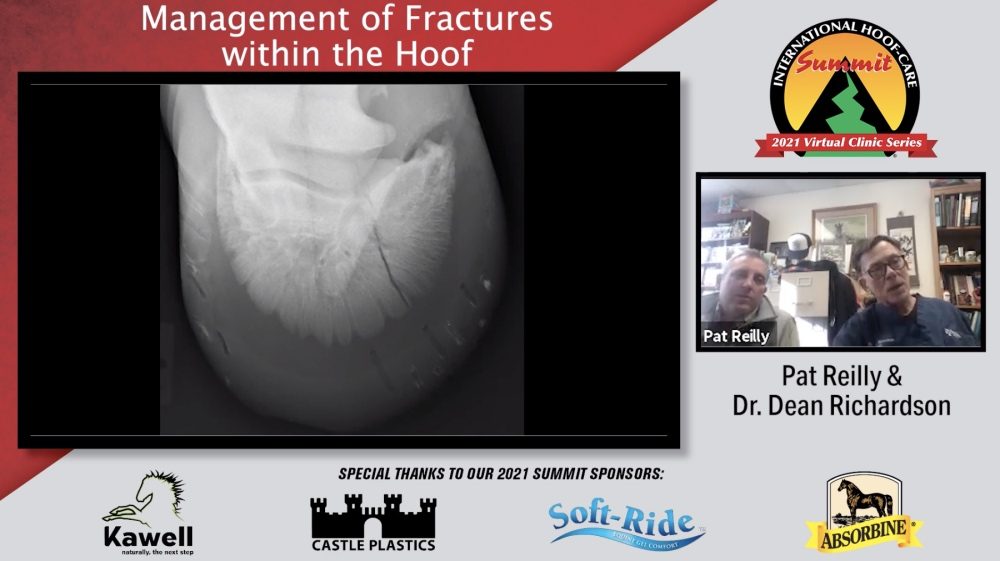An effective veterinarian-farrier team is essential for achieving the best results when treating hoof fractures.
In their International Hoof-Care Summit — 2021 Virtual Clinic Series presentation “Management of Fractures within the Hoof,” Dr. Dean Richardson and Pat Reilly of the University of Pennsylvania’s New Bolton Center discuss practical approaches to addressing fractures and why their work with each other is critical for the horse.
“Among the goals of shoeing and managing fractures is stabilizing the foot in some way,” Reilly says. “There are all kinds of ideas of combinations of bar shoes, multiple clips and continuous rim shoes. It makes sense to say, let’s just limit the foot, then we’ll stabilize the fracture.”
Yet, scientific research doesn’t support that notion.
“We know, for instance, that with laminitic horses there’s no amount of pressure that you can put on a heart-bar shoe that’s going to prevent the descent and movement of the bone inside the foot,” he says. “There’s a study that came out a few years ago looking at our abilities to stabilize the foot. All of these shoes with the clips are designed to prevent the outward movement or expansion of the foot. But, what happens with horses is that not only does the foot expand, it actually contracts as much as the foot is unrolling, about the same amount that it is expanding. These shoes do very little that would serve to stabilize the foot when the foot is contracted.”
Thus, Richardson and Reilly prefer internal fixation — inserting a sterilized screw into the bone to promote healing — when treating common cracks that go through the bone.
“Standardbred racing horses get these repetitive injuries often because they run very fast on very hard surfaces,” Richardson explains. “This fracture involves the coffin joint. If you leave it unstable and it moves, the horse has a high tendency to end up with arthritis of the coffin joint.”
The game changer for successfully treating these injuries is the common use of computer tomography — or CT scanning.
“The way to think about CT is that it produces slices that allows us to see the fracture, the bone structures, as well as everything in the hoof in a 3-dimensional sense,” Richardson says. “The more difficult the fracture is to get a screw in, the more essential it is to use this technique.”
Hoof preparation is critical for a successful outcome. The vet-farrier team removes the superficial layer of hoof capsule and scrubs it for 6 minutes with povidone-iodine soap. Despite the precautions, risk for infection remains.
“The hoof is a very porous material and no matter how much we try to prepare this, there’s no way that we can absolutely remove all of the organisms from the surface of the foot,” Reilly says. “That’s one of the limitations that we know going into any surgery involving the foot.”
After foot prep and completion of the surgical procedure to internally secure the fracture, Reilly shoes the horse with a SoundHorse Technologies Sigafoos Morrison wedge Roller Motion shoe with a hospital plate.
“The fabric cuff is easier to apply on an anesthetized horse than it is too nail on shoes,” Reilly says. “It also helps provide another layer of support to hold the incision patch in place. The 1/8- or 3/16-inch hospital plate provides more stability of the foot and I set back the shoe to ease breakover. I don’t want torquing of the foot, so I use stainless steel slot head screws and countersink them into the plate so the foot pivots on the ground.”
To learn more about the use of impression material and follow-up care, be sure to watch the complete presentation. If you’re not registered for the International Hoof-Care Summit — 2021 Virtual Clinic Series and would like to watch the presentation by Richardson and Reilly or 17 other informative Therapeutic Shoeing sessions in February, you can do so here. In addition, you will be automatically signed up for a special live Q&A session at 7 p.m. CST on Tuesday, Feb. 16 in which Reilly answers your questions. Each month, the IHCS will tackle a different hoof-care theme. By registering today, you will have access to February’s sessions, as well as those that follow through September. In addition, you will be automatically signed up to attend live online panel discussions, as well as live question-and-answer sessions.







